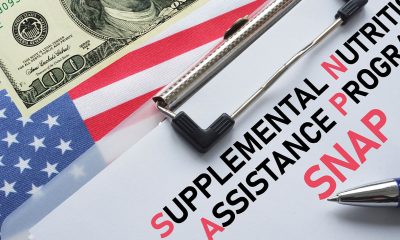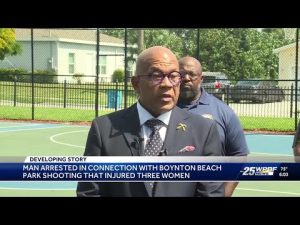Bay Area
National Coalition of 100 Black Women SF ‘Hats and Gloves’ Tea Returns

By Carla Thomas
Glamorous hats, St. John suits, Ferragamo shoes, and more glitzy fashion adorned some of the most powerful women in the San Francisco Bay Area at the National Coalition of 100 Black Women (NCBW) SF Golden Girls Hats and Gloves Tea.
Themed “Bridging the Generations,” the event was held in the Venetian Room of the Nob Hill Fairmont Hotel on Saturday, March 11, where more than 400 women celebrated the beauty, strength and resilience of Black women.
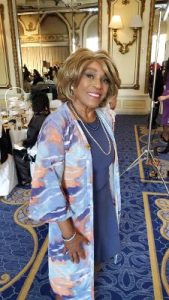
Frances Cohen, president of the National Coalition of 100 Black Women (NCBW) SF chapter at the Golden Girls Hats and Gloves Tea. Photo by Carla Thomas.
The annual fundraiser gave guests an afternoon of sipping tea, sampling desserts and appetizers while exchanging stories, and sharing a special bond with other Black women in the community.
Guests also took pictures, participated in both silent and live auctions with proceeds benefitting the NCBW-SF’s educational, financial and civic programs. Due to the pandemic, the in-person tea event had been postponed for three years.
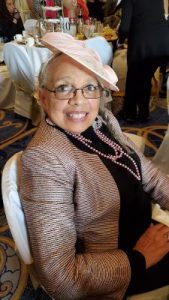
Ida Hurst is pretty in pink at the National Coalition of 100 Black Women (NCBW) SF Golden Girls Hats and Gloves Tea. Photo by Carla Thomas.
A passion-filled keynote speech by educator and community advocate Dr. Veronica Hunnicutt, founder of the Hunnicutt Foundation, encouraged established women to assist other women on their career, educational and political journeys.
“Were it not for the Honorable Doris Ward, I would not have had the numerous opportunities I’ve had,” Hunnicutt said. “Exercise your gifts, they will carry you far.”
Hunnicutt is also the author of the “Straight Talk,” book series to empower young Black men and women. Well known as an education change agent, she serves as dean for San Francisco City College’s Southeast campus in the Bay View district of the city.
During her speech, Hunnicutt humbly gave thanks to NCBW SF president Sharon Lee and shared the accomplishments of comrades and colleagues throughout the room. She also paid homage to her own mother for providing a solid foundation in life and for being a straight-forward parent.
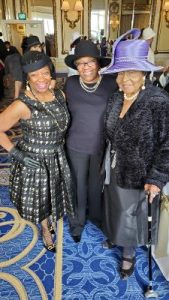
Guests (l-r) Mary Cole, Barbara Henry and Mary Dixon show off their outfits at the National Coalition of 100 Black Women (NCBW) SF Golden Girls Hats and Gloves Tea, “Bridging the Generations.” Photo by Carla Thomas.
Honorees of excellence included Wanda M. Holland Green of The Hamlin School who was presented with the Education Award. Joi Jackson Morgan of Third Street Youth Center and Clinic received the Trailblazer Award, and the Community Service Award was presented to Shakirah Simley of the Booker T. Washington Community Service Center.
Ingrid Merriwether of Merriwether & Williams Insurance received the Entrepreneur Award and Aline Armstrong of the San Francisco Department of Public Health received the Health Award.
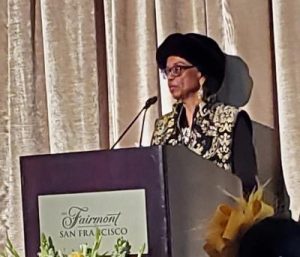
Dr. Veronica Hunnicutt praised her mother and Doris Ward in her keynote address for the National Coalition of 100 Black Women (NCBW) SF Golden Girls Hats and Gloves Tea. Photo by Carla Thomas.
The Art Award was presented to visual artist, Karen Seneferu, founder of “The Black Woman is GOD” exhibit and the Advocacy Award was presented to Healing 4 Our Families & Our Nation founder, Mattie Scott. The Golden Girl Award was presented to Cathy Davis of the Bay View Senior Services Agency and the Golden State Warriors received the Corporate Award.
NCBW SF President, Sharon Lee said, “I am so grateful to have the opportunity to have our Tea in person and honor eight individuals and one corporation who have demonstrated their commitment to supporting our community.”
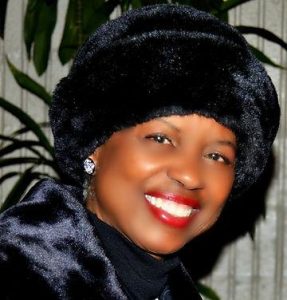
Dr. Veronica Hunnicutt, CEO of the Hunnicutt Foundation keynotes the National Coalition of 100 Black Women (NCBW) SF Golden Girls Hats and Gloves Tea. Photo courtesy NCBW SF.
Health Committee Chair Carletta Jackson Lane said, “The thing I love most about our Tea is that it allows Black women to come together in one place to enjoy each other and celebrate each other as we raise funds for our community programming.”
Former president of the organization Maxine Hickman of Hickman Homes said, “our Tea gives us an opportunity to celebrate the best of us by awarding our honorees and raising funds for our year-round programming in education, health, economic empowerment, and public policy.”
The events program booklet featured an ad for the Doris Ward Workforce Job Training Program offering women ages 18-59 a paid leadership development skills course. For more information visit: ncbw-sf.org.
Alameda County
Seth Curry Makes Impressive Debut with the Golden State Warriors
Seth looked comfortable in his new uniform, seamlessly fitting into the Warriors’ offensive and defensive system. He finished the night with an impressive 14 points, becoming one of the team’s top scorers for the game. Seth’s points came in a variety of ways – floaters, spot-up three-pointers, mid-range jumpers, and a handful of aggressive drives that kept the Oklahoma City Thunder defense on its heels.

By Y’Anad Burrell
Tuesday night was anything but ordinary for fans in San Francisco as Seth Curry made his highly anticipated debut as a new member of the Golden State Warriors. Seth didn’t disappoint, delivering a performance that not only showcased his scoring ability but also demonstrated his added value to the team.
At 35, the 12-year NBA veteran on Monday signed a contract to play with the Warriors for the rest of the season.
Seth looked comfortable in his new uniform, seamlessly fitting into the Warriors’ offensive and defensive system. He finished the night with an impressive 14 points, becoming one of the team’s top scorers for the game. Seth’s points came in a variety of ways – floaters, spot-up three-pointers, mid-range jumpers, and a handful of aggressive drives that kept the Oklahoma City Thunder defense on its heels.
One of the most memorable moments of the evening came before Seth even scored his first points. As he checked into the game, the Chase Center erupted into applause, with fans rising to their feet to give the newest Warrior a standing ovation.
The crowd’s reaction was a testament not only to Seth’s reputation as a sharpshooter but also to the excitement he brings to the Warriors. It was clear that fans quickly embraced Seth as one of their own, eager to see what he could bring to the team’s championship aspirations.
Warriors’ superstar Steph Curry – Seth’s brother – did not play due to an injury. One could only imagine what it would be like if the Curry brothers were on the court together. Magic in the making.
Seth’s debut proved to be a turning point for the Warriors. Not only did he contribute on the scoreboard, but he also brought a sense of confidence and composure to the floor.
While their loss last night, OKC 124 – GSW 112, Seth’s impact was a game-changer and there’s more yet to come. Beyond statistics, it was clear that Seth’s presence elevated the team’s performance, giving the Warriors a new force as they look to make a deep playoff run.
Activism
Oakland Post: Week of November 26 – December 2, 2025
The printed Weekly Edition of the Oakland Post: Week of November 26 – December 2, 2025

To enlarge your view of this issue, use the slider, magnifying glass icon or full page icon in the lower right corner of the browser window.
Activism
Oakland Post: Week of November 19 – 25, 2025
The printed Weekly Edition of the Oakland Post: Week of November 19 – 25, 2025

To enlarge your view of this issue, use the slider, magnifying glass icon or full page icon in the lower right corner of the browser window.
-

 Activism4 weeks ago
Activism4 weeks agoOakland Post: Week of November 5 – 11, 2025
-

 Activism3 weeks ago
Activism3 weeks agoOakland Post: Week of November 12 – 18, 2025
-

 Activism2 weeks ago
Activism2 weeks agoIN MEMORIAM: William ‘Bill’ Patterson, 94
-

 Activism3 weeks ago
Activism3 weeks agoHow Charles R. Drew University Navigated More Than $20 Million in Fed Cuts – Still Prioritizing Students and Community Health
-

 #NNPA BlackPress3 weeks ago
#NNPA BlackPress3 weeks agoThe Perfumed Hand of Hypocrisy: Trump Hosted Former Terror Suspect While America Condemns a Muslim Mayor
-

 #NNPA BlackPress3 weeks ago
#NNPA BlackPress3 weeks agoProtecting Pedophiles: The GOP’s Warped Crusade Against Its Own Lies
-

 Bay Area3 weeks ago
Bay Area3 weeks agoNo Justice in the Justice System
-

 #NNPA BlackPress4 weeks ago
#NNPA BlackPress4 weeks ago2026 Subaru Forester Wilderness Review: Everyday SUV With Extra Confidence



